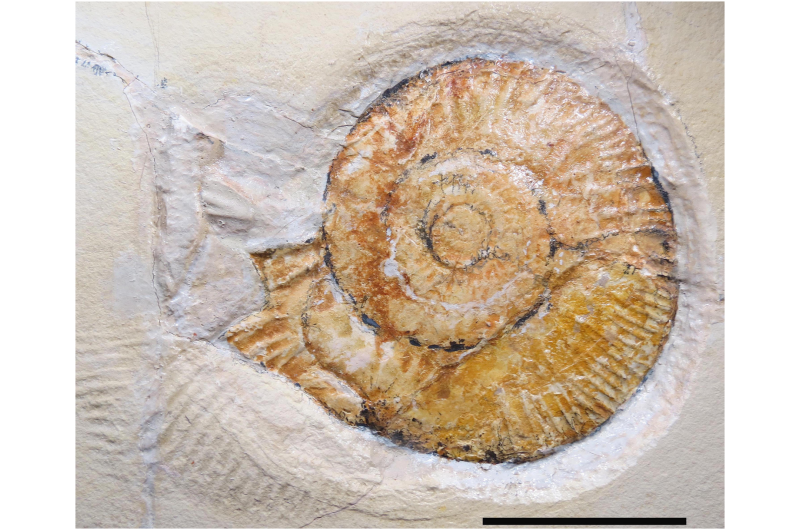The ammonite Subplanites rueppellianus, the producer of the drag mark (MCFO 0492). Credit: PLOS ONE (2017). DOI: 10.1371/journal.pone.0175426
(Phys.org)—A team of workers with members from institutions in the U.K., Germany and Spain has put online a digitized 3-D model of the "death drag" of an ammonite fossil—it is one of the longest ever found for such an ancient creature. They have also written a paper describing both the death drag and fossil and have posted it on the open access site PLOS ONE.
A death drag is a mark left behind by a creature that recently died and was moved or dragged by another force—in this case, it was an ammonite, a mollusk with a spiral shell that lived in the sea approximately 150 million years ago. It was dragged along the sea floor after it died by the sea current and left behind a very shallow trench. Finding a death drag from a creature millions of years ago is very rare, of course, because it requires a very specific set of circumstances to occur for preservation and discovery. In this case, it was a team of paleontologists digging at a quarry back in the 1990s at a site near the town of Solnhofen in Germany—many other ancient fossils have been found there. The ammonite and its death drag were preserved and were eventually put on display in a museum in Barcelona.
The death drag is approximately 8.5 meters long and grows more defined the closer it gets to the ammonite fossil. Prior research has suggested that the sea creature (which was missing its lower jaw, offering proof that it was dead prior to being dragged) was clearly quite buoyant when it began scraping the bottom, due to decomposition gasses inside of its shell—thus, it was just barely touching the bottom and able to leave only grooves at the edges. As time passed, gas seeped from the shell and the creature was dragged more heavily through the sediment, leaving a more defined trench. Prior research also suggested the trench was likely at a depth of 20 to 60 meters and was likely created due to a gentle underwater current.
In this new effort, the researchers used a technique called photogrammetry to create digitized imagery of the death drag and the fossil—hundreds of images were made from multiple angles which were all stitched together to create a 3-D model. The result is a model available for download or online in video format.
More information: Dean R. Lomax et al. An 8.5 m long ammonite drag mark from the Upper Jurassic Solnhofen Lithographic Limestones, Germany, PLOS ONE (2017). DOI: 10.1371/journal.pone.0175426
Abstract
Trackways and tracemakers preserved together in the fossil record are rare. However, the co-occurrence of a drag mark, together with the dead animal that produced it, is exceptional. Here, we describe an 8.5 m long ammonite drag mark complete with the preserved ammonite shell (Subplanites rueppellianus) at its end. Previously recorded examples preserve ammonites with drag marks of < 1 m. The specimen was recovered from a quarry near Solnhofen, southern Germany. The drag mark consists of continuous parallel ridges and furrows produced by the ribs of the ammonite shell as it drifted just above the sediment surface, and does not reflect behaviour of the living animal.
Journal information: PLoS ONE
© 2017 Phys.org
























